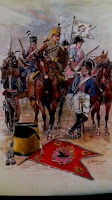came across, via Wiki Commons, this very interesting painting - not large enough to study the detail - but still very interesting in my opinion, as it may show an Oriental - Polish, Turkish, Hungarian or perhaps a Syrian or Persian/Turkoman - male horse (a stallion or gelding) a beautiful golden bay, dun or buckskin with a blaze on his intelligent face and four socks on his legs. Both dun and buckskin (see horse colors article from Practical Horseman) were popular horse colors with our Old Polish horses - also palomino, spotted etc.
Mid-XVII century Dutch liked their horses to have their tail docked, oh, well, that was then (the British continued this practice into the XX century, unfortunately).
It is quite unusual in the Dutch XVII century paintings.

Enjoy this bit enlarged view.

Valete























































